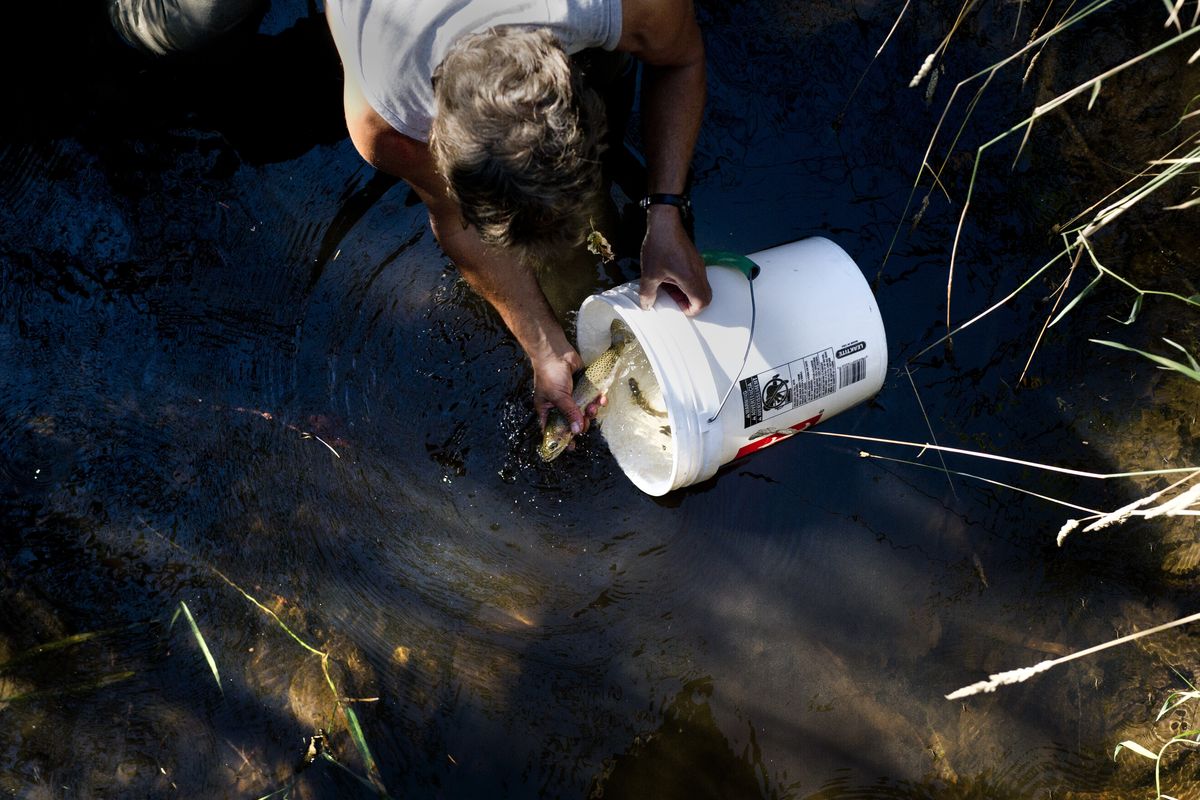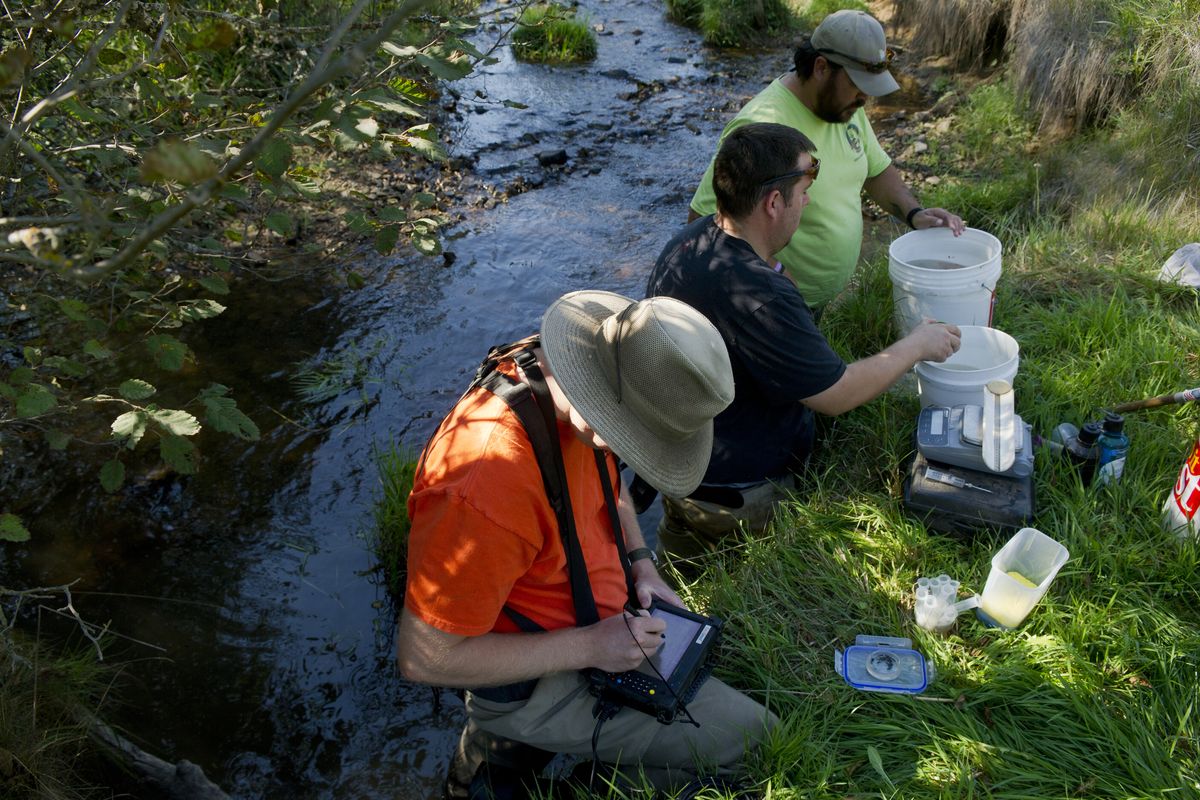Tribal study seeks to restore cutthroat population
Benewah Creek sees upswing in juvenile trout, but few survive pike-infested lake
Daniel Jolibois, a fisheries technician, releases a cutthroat trout on Friday in Plummer, Idaho. The Coeur d’Alene Tribe is working to restore cutthroat populations on its reservation. (Tyler Tjomsland)Buy a print of this photo
PLUMMER, Idaho – Years of restoration work have turned Benewah Creek into ideal habitat for Idaho’s state fish, the cutthroat trout.
Earlier this month, the Coeur d’Alene Tribe’s fisheries technicians counted 120 juvenile westslope cutthroat in a short stretch of the meandering stream, which is packed with the deep pools and insects that the trout like.
Despite the high counts, the youngsters’ outlook is relatively grim. Most of the cutthroat will migrate to Lake Coeur d’Alene when they reach two years of age. Out of the group of 120, only two or three fish will return to Benewah Creek as adults to spawn.
The tribal fisheries department is trying to figure out why cutthroat survival is so low in the lake. Ongoing research indicates that northern pike, a non-native predator in Lake Coeur d’Alene, is quelling cutthroat populations. What the study reveals could help other populations of Idaho’s iconic fish.
Sleek and speckled, cutthroat are named for two slashlike indentations under their jaw. The fish are a favorite of anglers because of their readiness to bite. Their beauty is also part of their draw.
“It’s hard to find a critter prettier than a cutthroat when they’re colored up” for spawning, said Chip Corsi, the Idaho Department of Fish and Game’s regional supervisor. “They’re red and gold and speckled. They’re fun to look at.”
Historically abundant, cutthroat provided an important food source for the early settlers and the Coeur d’Alene Tribe, whose ancestors harvested the trout they call eltumish in Lake Coeur d’Alene’s tributaries for hundreds, perhaps thousands, of years.
Early accounts describe tribal members setting fish traps across the St. Joe and Spokane rivers to catch cutthroat, said Angelo Vitale, the tribe’s fisheries program manager.
As late as the early 1980s, thousands of cutthroat returned to the lake’s tributary streams. After the runs dwindled, the tribe closed cutthroat-bearing creeks on the Coeur d’Alene Reservation to fishing. Statewide, fishing for cutthroat is primarily catch-and-release, with some limited harvest.
Cutthroat need clean, cold water to thrive, which makes the fish an indicator of watershed health. Over the past century, Idaho’s cutthroat runs have been diminished by blocked access to spawning grounds, agricultural development of flood plains, industrial pollution and introduced species that compete with cutthroat for food.
For local runs, what happens in Lake Coeur d’Alene is also critical.
Only about 2 percent of cutthroat are returning to their natal streams on the Coeur d’Alene Reservation to spawn, said Jon Firehammer, the tribe’s research fisheries biologist. Based on healthy populations in other areas, the figure should be closer to 15 percent, he said.
At this point, the evidence points to northern pike as a culprit. Pike, which can reach 35 pounds, were illegally planted in Lake Coeur d’Alene during the 1970s. They spawn in the lake’s weedy, shallow bays, intercepting the young cutthroat moving down from the tributaries.
The tribe is contracting with the University of Idaho to evaluate how many cutthroat the northern pike consume. The pike are caught and forced to regurgitate so their stomach contents can be studied, Firehammer said. Then the pike are tagged and released back into the lake.
By December, results from the two-year study will be available. The study should reveal how large a role pike play in depressing cutthroat runs in the lake, said Vitale, the tribe’s fisheries program manager.
Even if pike are large consumers of cutthroat, there may not be a simple solution, Corsi cautioned.
In an effort to keep the non-native predator in check, Idaho Fish and Game has lifted bag limits on northern pike. And in Northeastern Washington, members of the Kalispell Tribe and the state Department of Fish and Wildlife are gillnetting northern pike to reduce numbers on the Box Canyon Reservoir stretch of the Pend Oreille River. But once they’re introduced into ecosystems, nonnative species are nearly impossible to eradicate, Corsi said.
Earlier this month, tribal fisheries technicians ran mild electrical currents through Benewah Creek, shocking the waters so they could net young cutthroat. The fish were measured, weighed and outfitted with a transmitter the size of a grain of rice before being released into the creek.
Each transmitter has a unique code, which allows the tribal fisheries department to track the cutthroats’ movements, including how many adults return to spawn.
Members of the Coeur d’Alene Tribe regularly asked Vitale when the runs will be strong enough to reopen a fishing season. Many recall trout-filled streams during the spring spawning season. Despite the complications of a changing ecosystem, Vitale’s hopeful that day will come.
Cutthroat are quite resilient, he said. Unlike salmon, they don’t die after laying and fertilizing eggs. Cutthroat can live for about a decade, spawning multiple times.
If the tribe can find a way to make the lake more hospitable to cutthroat, a centuries old fishery could be revived, Vitale said.

